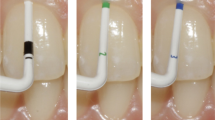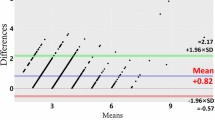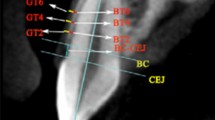Abstract
Objectives
To investigate the diagnostic value of probe transparency related to gingival thickness (GT) and keratinized gingival width (KGW) at individual and site levels and explore the relationship of buccal bone plate thickness (BT) with GT and KGW.
Materials and methods
A total of 1,606 teeth from 167 patients with periodontally healthy maxillary anterior region were included. GT was measured with probe transparency and transgingival probing. KGW was measured directly. BTs were assessed at the level 1 mm apical to the alveolar crest (BT1) and midpoint of the root (BT2) and evaluated at individual and tooth levels along with their mutual associations.
Results
The prevalence of thick gingiva was 53% with probe transparency measurement and 51% with transgingival probing. The cutoff gingival thickness was 0.8 mm, which correlated moderately with a Cohen’s kappa of 0.386. The mean GT, KGW, and BTs (BT1 and BT2) in the maxillary anterior region were 0.97 ± 0.46, 5.51 ± 1.62, 0.85 ± 0.31, and 0.79 ± 0.32 mm, respectively. GT and KGW correlated mildly (r = 0.261), and GT and BTs correlated moderately (BT1: r = 0.298; BT2: r = 0.338). GT and BTs differed significantly between men and women and among different tooth sites.
Conclusions
GT and BTs correlated positively in the maxillary anterior region and varied within and among individuals. Sex was a factor influencing the gingival phenotype and bone morphotype.
Clinical relevance
GT measured with transgingival probing, with a cutoff of 0.8 mm, could serve as an objective measure to distinguish different gingival phenotypes.

Similar content being viewed by others
Data availability
The data that support the fndings of this study are available from the corresponding author upon reasonable request.
References
Kim DM, Bassir SH, Nguyen TT (2020) Effect of gingival phenotype on the maintenance of periodontal health: An American Academy of Periodontology best evidence review. J Periodontol 91:311–338. https://doi.org/10.1002/JPER.19-0337
Jepsen S, Caton JG, Albandar JM, Bissada NF, Bouchard P, Cortellini P, Demirel K, de Sanctis M, Ercoli C, Fan J, Geurs NC, Hughes FJ, Jin L, Kantarci A, Lalla E, Madianos PN, Matthews D, McGuire MK, Mills MP, Preshaw PM, Reynolds MA, Sculean A, Susin C, West NX, Yamazaki K (2018) Periodontal manifestations of systemic diseases and developmental and acquired conditions: Consensus report of workgroup 3 of the 2017 World Workshop on the Classification of Periodontal and Peri-Implant Diseases and Conditions. J Periodontol 89(Suppl 1):S237–S248. https://doi.org/10.1002/JPER.17-0733
Claffey N, Shanley D (1986) Relationship of gingival thickness and bleeding to loss of probing attachment in shallow sites following nonsurgical periodontal therapy. J Clin Periodontol 13:654–657. https://doi.org/10.1111/j.1600-051x.1986.tb00861.x
van Eekeren P, van Elsas P, Tahmaseb A, Wismeijer D (2017) The influence of initial mucosal thickness on crestal bone change in similar macrogeometrical implants: a prospective randomized clinical trial. Clin Oral Implants Res 28:214–218. https://doi.org/10.1111/clr.12784
Chen ZY, Zhong JS, Ouyang XY, Zhou SY, Xie Y, Lou XZ (2020) Gingival thickness assessment of gingival recession teeth. Beijing Da Xue Xue Bao Yi Xue Ban 52:339–345. https://doi.org/10.19723/j.issn.1671-167X.2020.02.023
Aslan S, Clauser T, Testori T, Del Fabbro M, Rasperini G (2021) A Novel Technique for the Estimation of Gingival Thickness: A Preliminary Study. Int J Periodontics Restorative Dent 41:571–577. https://doi.org/10.11607/prd.4947
Fischer KR, Buchel J, Testori T, Rasperini G, Attin T, Schmidlin P (2021) Gingival phenotype assessment methods and classifications revisited: a preclinical study. Clin Oral Investig 25:5513–5518. https://doi.org/10.1007/s00784-021-03860-5
Bertl K, Al-Hotheiry M, Sun D, Olofsson J, Lettner S, Gotfredsen K, Stavropoulos A (2022) Are colored periodontal probes reliable to classify the gingival phenotype in terms of gingival thickness? J Periodontol 93:412–422. https://doi.org/10.1002/JPER.21-0311
Kan JY, Morimoto T, Rungcharassaeng K, Roe P, Smith DH (2010) Gingival biotype assessment in the esthetic zone: visual versus direct measurement. Int J Periodontics Restorative Dent 30:237–243. https://doi.org/10.11607/prd.00.0918
Sharma S, Thakur SL, Joshi SK, Kulkarni SS (2014) Measurement of gingival thickness using digital vernier caliper and ultrasonographic method: a comparative study. J Investig Clin Dent 5:138–143. https://doi.org/10.1111/jicd.12026
Muller HP, Heinecke A, Schaller N, Eger T (2000) Masticatory mucosa in subjects with different periodontal phenotypes. J Clin Periodontol 27:621–626. https://doi.org/10.1034/j.1600-051x.2000.027009621.x
Alpiste-Illueca F (2004) Dimensions of the dentogingival unit in maxillary anterior teeth: a new exploration technique (parallel profile radiograph). Int J Periodontics Restorative Dent 24:386–396. https://doi.org/10.11607/prd.00.0587
Rodrigues DM, Petersen RL, de Moraes JR, Barboza EP (2022) Gingival landmarks and cutting points for gingival phenotype determination: A clinical and tomographic cross-sectional study. J Periodontol 93:1916–1928. https://doi.org/10.1002/JPER.21-0615
Aguilar-Duran L, Mir-Mari J, Figueiredo R, Valmaseda-Castellon E (2020) Is measurement of the gingival biotype reliable? Agreement among different assessment methods. Med Oral Patol Oral Cir Bucal 25:e144–e149. https://doi.org/10.4317/medoral.23280
Malpartida-Carrillo V, Tinedo-Lopez PL, Guerrero ME, Amaya-Pajares SP, Ozcan M, Rosing CK (2021) Periodontal phenotype: A review of historical and current classifications evaluating different methods and characteristics. J Esthet Restor Dent 33:432–445. https://doi.org/10.1111/jerd.12661
Wang J, Cha S, Zhao Q, Bai D (2022) Methods to assess tooth gingival thickness and diagnose gingival phenotypes: A systematic review. J Esthet Restor Dent 34:620–632. https://doi.org/10.1111/jerd.12900
Frost NA, Mealey BL, Jones AA, Huynh-Ba G (2015) Periodontal Biotype: Gingival Thickness as It Relates to Probe Visibility and Buccal Plate Thickness. J Periodontol 86:1141–1149. https://doi.org/10.1902/jop.2015.140394
Nikiforidou M, Tsalikis L, Angelopoulos C, Menexes G, Vouros I, Konstantinides A (2016) Classification of periodontal biotypes with the use of CBCT. A cross-sectional study Clin Oral Investig 20:2061–2071. https://doi.org/10.1007/s00784-015-1694-y
Amid R, Mirakhori M, Safi Y, Kadkhodazadeh M, Namdari M (2017) Assessment of gingival biotype and facial hard/soft tissue dimensions in the maxillary anterior teeth region using cone beam computed tomography. Arch Oral Biol 79:1–6. https://doi.org/10.1016/j.archoralbio.2017.02.021
De Rouck T, Eghbali R, Collys K, De Bruyn H, Cosyn J (2009) The gingival biotype revisited: transparency of the periodontal probe through the gingival margin as a method to discriminate thin from thick gingiva. J Clin Periodontol 36:428–433. https://doi.org/10.1111/j.1600-051X.2009.01398.x
Eghbali A, De Rouck T, De Bruyn H, Cosyn J (2009) The gingival biotype assessed by experienced and inexperienced clinicians. J Clin Periodontol 36:958–963. https://doi.org/10.1111/j.1600-051X.2009.01479.x
Stein JM, Lintel-Hoping N, Hammacher C, Kasaj A, Tamm M, Hanisch O (2013) The gingival biotype: measurement of soft and hard tissue dimensions - a radiographic morphometric study. J Clin Periodontol 40:1132–1139. https://doi.org/10.1111/jcpe.12169
Cook DR, Mealey BL, Verrett RG, Mills MP, Noujeim ME, Lasho DJ, Cronin RJ Jr (2011) Relationship between clinical periodontal biotype and labial plate thickness: an in vivo study. Int J Periodontics Restorative Dent 31:345–354. https://doi.org/10.11607/prd.00.0985
Hsu YT, Huang NC, Wong A, Cobb C, Lee S, Mikail Y, Kao RT (2020) Periodontal Risk Assessment Based on Dental and Gingival Morphology: A Comparative Analysis of African Versus Asian American Cohorts. Clin Adv Periodontics 10:224–230. https://doi.org/10.1002/cap.10117
Lee WZ, Ong MMA, Yeo AB (2018) Gingival profiles in a select Asian cohort: A pilot study. J Investig Clin Dent 9:e12269. https://doi.org/10.1111/jicd.12269
Shao Y, Yin L, Gu J, Wang D, Lu W, Sun Y (2018) Assessment of Periodontal Biotype in a Young Chinese Population using Different Measurement Methods. Sci Rep 8:11212. https://doi.org/10.1038/s41598-018-29542-z
Egreja AM, Kahn S, Barceleiro M, Bittencourt S (2012) Relationship between the width of the zone of keratinized tissue and thickness of gingival tissue in the anterior maxilla. Int J Periodontics Restorative Dent 32:573–579. https://doi.org/10.11607/prd.00.1097
Shah R, Sowmya NK, Mehta DS (2015) Prevalence of gingival biotype and its relationship to clinical parameters. Contemp Clin Dent 6:S167–S171. https://doi.org/10.4103/0976-237X.166824
Mallikarjun S, Babu HM, Das S, Neelakanti A, Dawra C, Shinde SV (2016) Comparative evaluation of soft and hard tissue dimensions in the anterior maxilla using radiovisiography and cone beam computed tomography: A pilot study. J Indian Soc Periodontol 20:174–177. https://doi.org/10.4103/0972-124X.170813
La Rocca AP, Alemany AS, Levi P Jr, Juan MV, Molina JN, Weisgold AS (2012) Anterior maxillary and mandibular biotype: relationship between gingival thickness and width with respect to underlying bone thickness. Implant Dent 21:507–515. https://doi.org/10.1097/ID.0b013e318271d487
Shafizadeh M, Amid R, Tehranchi A, Motamedian SR (2022) Evaluation of the association between gingival phenotype and alveolar bone thickness: A systematic review and meta-analysis. Arch Oral Biol 133:105287. https://doi.org/10.1016/j.archoralbio.2021.105287
Chou YH, Tsai CC, Wang JC, Ho YP, Ho KY, Tseng CC (2008) New classification of crown forms and gingival characteristics in taiwanese. Open Dent J 2:114–119. https://doi.org/10.2174/1874210600802010114
Liu F, Pelekos G, Jin LJ (2017) The gingival biotype in a cohort of Chinese subjects with and without history of periodontal disease. J Periodontal Res 52:1004–1010. https://doi.org/10.1111/jre.12471
Nik-Azis NM, Razali M, Goh V, Ahmad Shuhaimi NN, MohdNazrin NAS (2023) Assessment of gingival thickness in multi-ethnic subjects with different gingival pigmentation levels. J Clin Periodontol 50:80–89. https://doi.org/10.1111/jcpe.13723
Esfahanizadeh N, Daneshparvar N, Askarpour F, Akhoundi N, Panjnoush M (2016) Correlation Between Bone and Soft Tissue Thickness in Maxillary Anterior Teeth. J Dent (Tehran) 13:302–308
Collins JR, Pannuti CM, Veras K, Ogando G, Brache M (2021) Gingival phenotype and its relationship with different clinical parameters: a study in a Dominican adult sample. Clin Oral Investig 25:4967–4973. https://doi.org/10.1007/s00784-021-03806-x
Alhajj WA (2020) Gingival phenotypes and their relation to age, gender and other risk factors. BMC Oral Health 20:87. https://doi.org/10.1186/s12903-020-01073-y
Fischer KR, Buchel J, Kauffmann F, Heumann C, Friedmann A, Schmidlin PR (2022) Gingival phenotype distribution in young Caucasian women and men - An investigative study. Clin Exp Dent Res 8:374–379. https://doi.org/10.1002/cre2.482
Vandana KL, Savitha B (2005) Thickness of gingiva in association with age, gender and dental arch location. J Clin Periodontol 32:828–830. https://doi.org/10.1111/j.1600-051X.2005.00757.x
Funding
The study was supported by National Natural Science Foundations of China (Project Number: 81800978) and the Peking University School and Hospital of Stomatology (PKUSSNCT- 20B10, PKUSS20200105). The funders had no role in the design of the study, collection, analysis or interpretation of the data, or in writing the manuscript.
Author information
Authors and Affiliations
Contributions
Y.Z. F.X. and Y.C. conceptualized the overall strategy. Y.Z and F.C. equally contributed to the clinical translation and implementation, and preparation of the manuscript and figures. N.K. and JY.D. designed and performed the statistical analyses and preparation of the manuscript, including text and figures. F.X. and Y.C. provided supervision and wrote and edited the manuscript. All authors have read and agreed to the published version of the manuscript.
Corresponding authors
Ethics declarations
Ethics approval and consent to participate
The Ethics Committee of the Peking University School and Hospital of Stomatology approved the study protocol. All procedures performed in studies involving human participants were in accordance with the ethical standards of the institutional and/or national research committee and with the 1964 Helsinki Declaration and its later amendments or comparable ethical standards.
Conflicts of interests
The authors declare that they have no conflict of interest.
Competing interests
The authors declare that they have no conflict of interest.
Additional information
Publisher's note
Springer Nature remains neutral with regard to jurisdictional claims in published maps and institutional affiliations.
Rights and permissions
Springer Nature or its licensor (e.g. a society or other partner) holds exclusive rights to this article under a publishing agreement with the author(s) or other rightsholder(s); author self-archiving of the accepted manuscript version of this article is solely governed by the terms of such publishing agreement and applicable law.
About this article
Cite this article
Zhang, Y., Chen, F., Kang, N. et al. Clinical and computed tomographic evaluations of periodontal phenotypes in a Chinese population: a cross-sectional study. Clin Oral Invest 27, 3569–3577 (2023). https://doi.org/10.1007/s00784-023-04970-y
Received:
Accepted:
Published:
Issue Date:
DOI: https://doi.org/10.1007/s00784-023-04970-y




